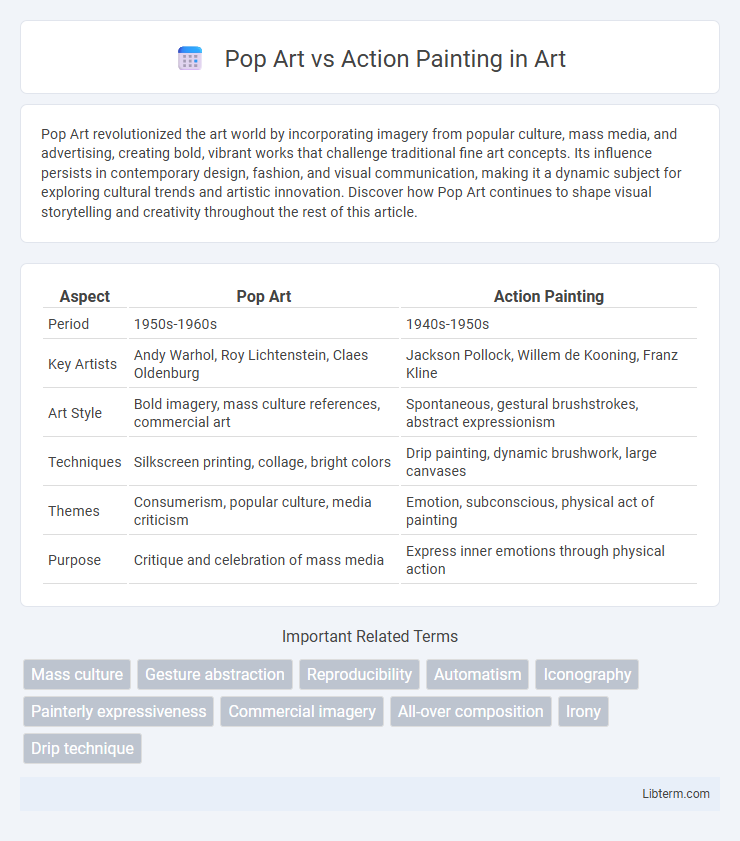Pop Art revolutionized the art world by incorporating imagery from popular culture, mass media, and advertising, creating bold, vibrant works that challenge traditional fine art concepts. Its influence persists in contemporary design, fashion, and visual communication, making it a dynamic subject for exploring cultural trends and artistic innovation. Discover how Pop Art continues to shape visual storytelling and creativity throughout the rest of this article.
Table of Comparison
| Aspect | Pop Art | Action Painting |
|---|---|---|
| Period | 1950s-1960s | 1940s-1950s |
| Key Artists | Andy Warhol, Roy Lichtenstein, Claes Oldenburg | Jackson Pollock, Willem de Kooning, Franz Kline |
| Art Style | Bold imagery, mass culture references, commercial art | Spontaneous, gestural brushstrokes, abstract expressionism |
| Techniques | Silkscreen printing, collage, bright colors | Drip painting, dynamic brushwork, large canvases |
| Themes | Consumerism, popular culture, media criticism | Emotion, subconscious, physical act of painting |
| Purpose | Critique and celebration of mass media | Express inner emotions through physical action |
Introduction to Pop Art and Action Painting
Pop Art emerged in the mid-1950s, characterized by its vivid imagery drawn from popular culture, including advertisements, comic books, and everyday consumer goods, challenging traditional fine art by integrating mass media and commercial elements. Action Painting, a subset of Abstract Expressionism developed in the 1940s and 1950s, emphasizes spontaneous, dynamic brushstrokes and the physical act of painting as an expressive performance, often focusing on the artist's gesture and movement. Both movements revolutionized art by diverging from representational norms: Pop Art celebrated external cultural visuals, while Action Painting highlighted internal emotional intensity through abstract forms.
Historical Origins: Pop Art vs Action Painting
Pop Art emerged in the mid-1950s in Britain and gained momentum in the United States during the late 1950s and early 1960s, rooted in a reaction against abstract expressionism and drawing inspiration from popular culture, advertising, and mass media. Action Painting developed in the late 1940s and early 1950s in New York City as a style of Abstract Expressionism, emphasizing spontaneous, dynamic brushstrokes and physical engagement with the canvas. Both movements reflect distinct historical origins: Pop Art highlights consumerism and media imagery, while Action Painting underscores individual emotion and gesture in post-World War II America.
Key Artists and Influencers
Pop Art, epitomized by Andy Warhol and Roy Lichtenstein, drew inspiration from commercial culture, mass media, and consumerism, using bold colors and iconic imagery to challenge traditional fine art. Action Painting, championed by Jackson Pollock and Willem de Kooning, emphasized dynamic brushstrokes and spontaneous, gestural techniques to convey emotion and subconscious movement. Both movements significantly shaped modern art, with Pop Art influencing graphic design and advertising, while Action Painting advanced abstract expressionism and personal expression.
Artistic Techniques and Methods
Pop Art utilizes bold colors, commercial imagery, and precise outlines often achieved through screen printing and collage techniques, emphasizing mass culture and consumerism. Action Painting emphasizes spontaneous, dynamic brushstrokes, drips, and splatters, reflecting physical movement and emotional intensity through gestural abstraction. These contrasting methods highlight Pop Art's controlled, deliberate approach versus Action Painting's impulsive, kinetic execution.
Themes and Subject Matter
Pop Art emphasizes consumer culture, mass media, and popular icons, often featuring bold, vibrant imagery drawn from advertising and comic books. Action Painting centers on the physical act of painting itself, highlighting spontaneous gestures and emotional intensity through abstract forms and dynamic brushstrokes. While Pop Art critiques and celebrates contemporary society, Action Painting explores individual expression and the subconscious mind.
Visual Style and Aesthetic Differences
Pop Art features bold, vibrant colors and clear, graphic imagery often derived from popular culture and mass media, emphasizing flatness and commercial aesthetics. Action Painting prioritizes dynamic brushstrokes and spontaneous, gestural marks, highlighting texture, movement, and emotional intensity through abstract forms. Pop Art's polished, reproducible look contrasts with Action Painting's raw, energetic surfaces, reflecting differing approaches to visual expression.
Cultural and Social Impact
Pop Art revolutionized visual culture by elevating everyday consumer goods and celebrity icons into celebrated art forms, reflecting and critiquing post-war consumerism and media saturation. Action Painting, rooted in Abstract Expressionism, emphasized spontaneous, dynamic brushstrokes that mirrored intense emotional energy and individual freedom during the Cold War era. Both movements reshaped societal perceptions of art by challenging traditional aesthetics and engaging with contemporary cultural dialogues.
Critical Reception Over Time
Pop Art initially received mixed reviews, with critics divided over its commercial imagery and perceived superficiality, but it gained widespread acclaim for challenging traditional art boundaries and influencing popular culture. Action Painting, associated with Abstract Expressionism, was praised in its early days for its dynamic gesture and emotional intensity, though some critics later questioned its lack of structure and narrative. Over time, both movements secured their places in art history, with Pop Art celebrated for its cultural commentary and Action Painting valued for its expressive technique.
Pop Art and Action Painting in Contemporary Culture
Pop Art, characterized by its vibrant imagery and incorporation of popular culture icons, continues to influence contemporary culture through its commentary on consumerism and mass media. Action Painting, rooted in Abstract Expressionism, emphasizes dynamic brushstrokes and spontaneous expression, impacting modern art by prioritizing process over product. Both movements shape contemporary visual language, with Pop Art foregrounding cultural symbols and Action Painting highlighting emotional intensity and artistic gesture.
Conclusion: Legacy and Lasting Influence
Pop Art revolutionized visual culture by integrating mass media imagery, influencing contemporary advertising and graphic design with its bold colors and irony. Action Painting emphasized the expressive potential of spontaneity and gesture, shaping Abstract Expressionism and paving the way for performance art and mixed media practices. Both movements permanently altered perceptions of art's role, fostering diverse approaches that continue to inspire artists globally.
Pop Art Infographic

 libterm.com
libterm.com